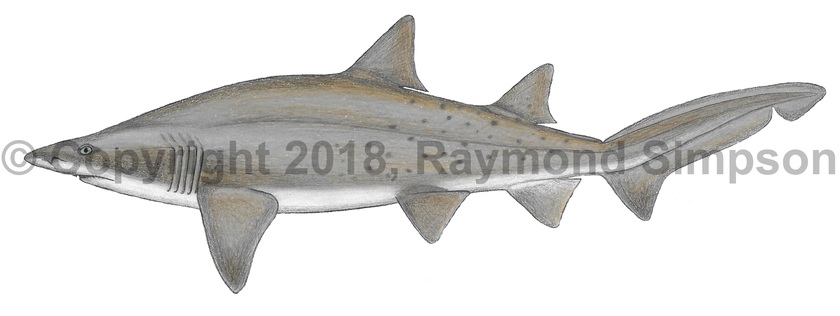
Common Name
Sand Tiger
Year Described
Rafinesque, 1810
Identification
Teeth rows: 36-54 upper, 32-46 lower
Body heavy and robust. Head and snout flattened with a large mouth with prominent teeth easily visible when mouth is closed. Snout short. Teeth long and thin with prominent single lateral cusplets. Post-oral grooves absent. Eye quite small. Gill slits large with last two closer together at pectoral origin. First dorsal fin placed well back on body (well behind rear tip of pectoral fin) and triangular. Second dorsal fin about the same size as D1. Pelvic and anal fins also placed far back on body with origin of each slightly posterior to origin of their corresponding dorsal fins. Lower fins about the same size as the dorsal fins. Pectoral fin large and rounded. Caudal fin with a strong upper and weak lower lobe. Subterminal notch strong. Precaudal pit only present dorsally. No lateral or peduncular keels. Skin rough.
Color
Body tan to pale reddish brown with numerous brown blotches and spots randomly distributed. Markings can be obvious or faint but are unique to individuals. Belly whitish. Fins darker brown with thin black rear margins.
Size
Maximum size to over 300cm TL. Mature adults from 190-230cm TL with females averaging much larger. Newborns over 85cm TL.
Habitat
A shallow water species (<250m but usually much shallower) commonly found in estuaries and near shore. Also found on soft bottoms, rocky reefs, coral reefs, and around shipwrecks.
Range
New Brunswick, Canada to Argentina. On continental margins in the Gulf of Mexico and Caribbean Sea.
References
Castro, J.I. 2011. The Sharks of North America. Oxford University Press, 640 pp.
Ebert, D. A., & M. Dando. 2020. Field Guide to Sharks, Rays & Chimaeras of Europe and the Mediterranean. Princeton University Press. 2020.